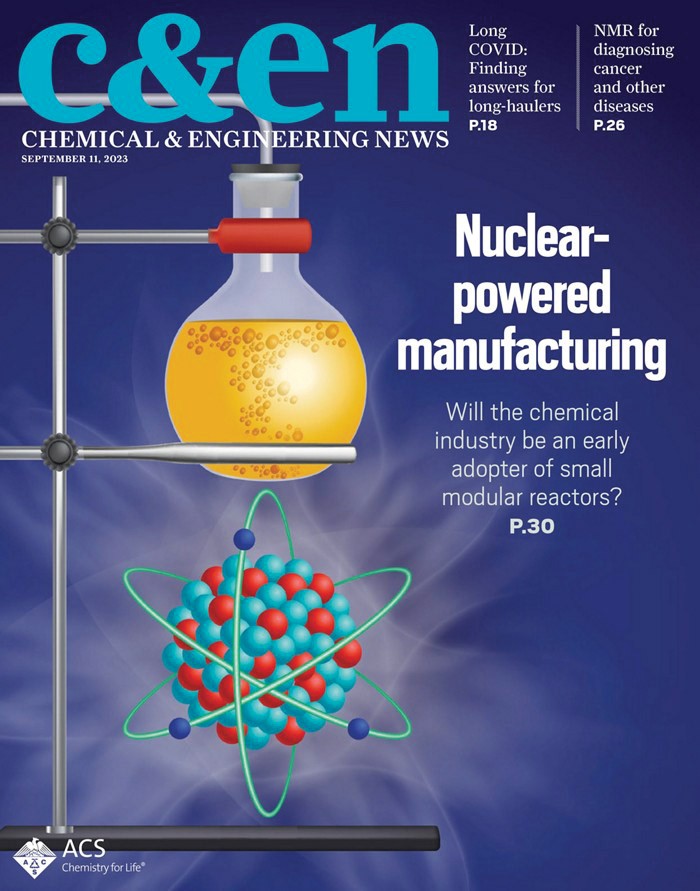Advertisement
Grab your lab coat. Let's get started
Welcome!
Welcome!
Create an account below to get 6 C&EN articles per month, receive newsletters and more - all free.
It seems this is your first time logging in online. Please enter the following information to continue.
As an ACS member you automatically get access to this site. All we need is few more details to create your reading experience.
Not you? Sign in with a different account.
Not you? Sign in with a different account.
ERROR 1
ERROR 1
ERROR 2
ERROR 2
ERROR 2
ERROR 2
ERROR 2
Password and Confirm password must match.
If you have an ACS member number, please enter it here so we can link this account to your membership. (optional)
ERROR 2
ACS values your privacy. By submitting your information, you are gaining access to C&EN and subscribing to our weekly newsletter. We use the information you provide to make your reading experience better, and we will never sell your data to third party members.
Letters to the editor
More on nuclear power
I am not sure we can stop or reverse climate change using current approaches, since Earth’s climate has changed significantly over time, much more than our short-term projections. We should strongly reconsider using thorium nuclear reactors for US and world energy needs to significantly reduce carbon dioxide emissions.
Thorium is over three times as abundant and more safely mined than uranium. Thorium power is safer because it cannot develop a runaway uncontrolled reaction like a uranium reactor. The thorium reactor by-products cannot make a nuclear bomb since the wrong isotopes are produced. Thorium reactors would produce less radioactive waste. These by-products are safe after about 100 years, versus 24,000 years for uranium reactors, and safe storage of thorium nuclear waste is much less complex. Uranium was chosen for nuclear power originally since it can be turned into nuclear weapons.
Notably, Edward Teller (father of the H-bomb), Glenn Seaborg (a former chair of the Atomic Energy Commission), Alvin Weinberg (a former Oak Ridge National Laboratory administrator), Kirk Sorensen, Carlo Rubbia (Nobel laureate and a former CERN director general), Hans Blix (a former International Atomic Energy Agency head), and V. J. Stenger—all noted nuclear physicists, have come out very strongly in favor of thorium reactors.
CANDU (Canadian deuterium uranium) thorium reactors have already been built. The US military has built megawatt-scale prototypes and evaluated them for up to 20 years, indicating that development work has been significant. Grid connection is not an issue since the electricity is continuously produced and is therefore steady and reliable. Many other nations could be provided safe and reliable electricity using thorium nuclear power.
Wind and solar energy are not steady and reliable. California and Texas had significant disruptions in 2020 and 2021. A proposed solar project in Nevada that was withdrawn would have been 36 km2 and would have generated only 0.85 GW of energy. Eighty percent of the solar panels are produced in China. The production is an environmental issue. Now is the time for thorium to be in the energy discussion. The US and the world need it.
Lawrence Ingram
Aliquippa, Pennsylvania
I totally agree with the comments of David Hauber in the C&EN issue of Sept. 27, 2021 (page 4).
Nuclear energy, especially produced by the newly developed thorium reactors, is the choice to minimize the amount of emitted carbon dioxide.
Renewables are not the ideal solution. In Germany, all nuclear reactors will be closed at the end of 2022. And then? These nuclear reactors have to be dismantled at a huge cost. The reactors that will be closed at the end of 2021 and 2022 could be running several years more. The technology is German. But no, one tsunami in Japan, and its consequences were enough to make this decision. In Europe, we do not have tsunamis, however.
Wind mills will now be built in the North Sea in huge parks. The beach visitors will like it, a nice view. The wind mills are killing many birds with their huge blades.
The word nuclear energy cannot be spoken about, a dirty word. Especially for climate-fascinated young people. Quo vadis these people?
Joop Koster
Gland, Switzerland
Green airlines
The cover story of the Sept. 6, 2021, issue of C&EN, “Airlines Want to Go Green” (page 28), which focused on carbon dioxide emissions, included on page 34 “Supersonic Flight’s Sustainability Challenge.” But carbon emissions are only a part of going green. Before Mario Molina and F. Sherwood Rowland described stratospheric ozone layer depletion from chlorofluorocarbons, Paul Crutzen warned of oxone layer depletion from the nitrogen oxides (NOx) that would be emitted as a combustion by-product from a fleet of stratospheric flying supersonic transports (SSTs). Congress then held hearings on the SST environmental challenge. Crutzen, Molina, and Rowland, received the Noble Prize for their work.
I am disappointed the stratospheric NOx threat to the environment from SSTs was not mentioned. It remains a significant concern.
Ronald Sheinson
Silver Spring, Maryland



Join the conversation
Contact the reporter
Submit a Letter to the Editor for publication
Engage with us on Twitter